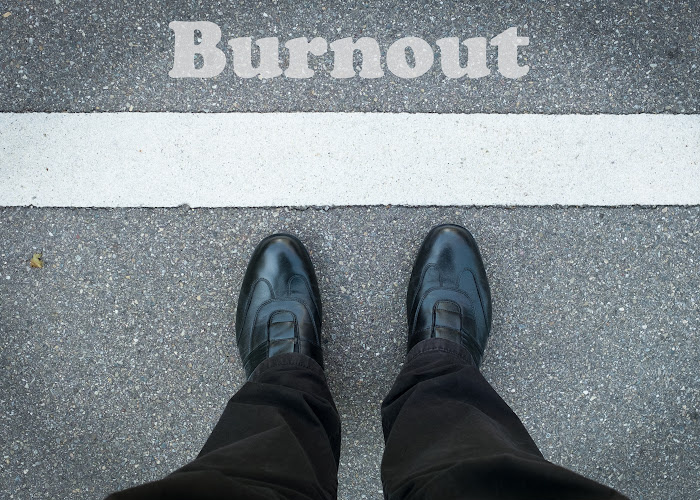It's crucial to know that students with autism and ADHD need special study strategies. Autism…

Autistic Burnout vs Depression: Understanding the Differences
When it comes to the complex landscape of mental health in autism, the concepts of autistic burnout and depression often intersect, leading to confusion and misinterpretation. Grasping the nuances between these conditions is more than mere semantics it’s a crucial aspect of managing autistic burnout and providing support where it’s truly needed. Autistic individuals experience burnout from the constant effort to assimilate into a neurotypical society, which can drain energy to a critical low, impacting their day-to-day functionality.
On the flip side, depression introduces a profound and persistent sadness that digs its roots across all facets of one’s life. Understanding these differences is an essential step toward the right direction in mental health support and care for those on the autism spectrum.
As complicated as both terms sound, the approach to handling them doesn’t have to be. Let’s delve into what makes these states distinct and explore clear pathways for recognizing and managing each effectively. Whether you’re a healthcare professional, a caregiver, or someone experiencing these challenges, recognizing the signs of autistic burnout versus depression is vital. It’s about making the distinction clear, providing the right kind of help, and ensuring better mental health in autism.

Defining Autistic Burnout and Depression
Understanding the markers of autistic burnout in adults and depression in autism is a key component in distinguishing between the two conditions. Autistic burnout symptoms manifest as an intense sensation of chronic exhaustion, a decline in social and life skills, and a heightened sensitivity to environmental stimuli. Renowned researchers, such as Raymaker et al., clinically define it as an enduring psychological syndrome resulting from a cumulative load of life stressors and an imbalance between individual capacities and societal expectations, accompanied by insufficient support.
On the other hand, depression symptoms in individuals with autism are characterized by an enduring low mood, a profound disinterest in activities once found enjoyable, and a general decrease in functioning. While both states share similarities in terms of the profound impact they have on one’s capabilities, they spring from distinct sources and prompt different approaches in management and care.
The repercussion of neglecting to appropriately recognize and differentiate these two conditions can be severe. Support strategies, therapeutic interventions, and management techniques differ greatly for each condition, emphasizing the importance of precision in their definition and understanding.
- Persistent exhaustion and inability to cope with sensory input are typical of autistic burnout symptoms.
- Depression in autistic individuals typically involves a pervasive and persistent feeling of sadness that extends across all aspects of life.
- A crucial element differentiating the two conditions is the lack of adequate support and discrepancy between abilities and demands in cases of autistic burnout.
As we continue to increase our knowledge and recognition of these conditions, it is evident that tailored interventions and comprehensive support systems are necessary for enhancing the mental health and overall well-being of those impacted by either autistic burnout or depression.

Recognizing the Signs of Autistic Burnout vs Depression
Discerning the differences between autistic burnout and depression is crucial for developing appropriate support strategies. While there are similarities in the symptoms, understanding the unique signs of each condition enables better management and prevention. Let’s explore the particular characteristics that set them apart.
Characteristics Distinct to Autistic Burnout
Autistic individuals face specific challenges that can lead to autistic burnout meltdown, a state where they experience overwhelming exhaustion and a reduced capacity to manage their emotions and sensory inputs. Other distinctive signs of autistic burnout include:
- Heightened sensitivity to environmental stimuli
- Increased frequency of repetitive behaviors
- Difficulty maintaining routine tasks and self-care
- Notable drop in social and communication skills
Recognizing these symptoms can help in identifying burnout early and managing autistic burnout effectively.
Depression Symptoms and their Nuances
Contrasting with autistic burnout, depression in autism is not solely triggered by external pressures to conform to neurotypical standards. Symptoms unique to depression may include:
- Persistent feelings of sadness and hopelessness
- Lack of energy and motivation in all aspects of life
- Social isolation that doesn’t fluctuate with stress leve
Understanding these nuances is crucial when considering depression vs burnout to ensure that individuals receive accurate diagnoses and the appropriate care.
The Subtleties of Overlapping Symptoms
Though some symptoms overlap, it’s the underlying factors that help distinguish between the two conditions. Shared symptoms like withdrawal and a reduced sense of well-being need careful examination to determine their root causes. This deeper look can reveal whether they stem from the autistic burnout triggers or are indicative of a more pervasive depressive disorder.
Autistic burnout prevention strategies may focus on reducing demands and sensory inputs, while managing depression might involve therapeutic approaches targeting mood and cognitive patterns. Differentiating between the two can guide the direction for treatment and recovery.
As we continue to understand the complexities of the autism spectrum and mental health, it’s imperative to prioritize personalized and nuanced care. With the right tools and knowledge, those experiencing autistic burnout or depression can pave a path toward recovery and resilience.
Exploring the Causes and Contributing Factors
Understanding the causes of autistic burnout is essential for creating supportive environments for recovery. Individuals on the autism spectrum face daily challenges that can culminate in burnout, such as the pressure of camouflaging their authentic selves to comply with societal norms. This often involves the daunting task of masking inherent autistic behaviors to blend in with others, potentially leading to a buildup of exhaustion and stress.
Autistic burnout recovery often requires addressing the core issues that lead to the state of burnout. This involves recognizing and reducing the demands for masking, providing accommodations for sensory sensitivities, and establishing supportive strategies designed to minimize the overload from managing multiple tasks.
- Camouflaging in social situations
- Dealing with sensory-rich environments
- Continuous multitasking
Depression, on the other hand, may stem from different origins. Effective depression treatment considers a holistic approach, focusing on the complex interplay of genetics, environment, and personal psychology. It is important for both individuals and healthcare providers to recognize the multifaceted nature of depression and tailor interventions to fit the unique needs of each person.
- Genetic predisposition
- Psychological stressors
- Environmental factors
Recognizing these factors is a significant step towards empowering individuals through personalized support and therapeutic modalities aimed at fostering resilience and well-being.

Conclusion
As we explore the complex terrain of mental health in autism, it’s clear that the key to improving outcomes lies in the precision of identification. Accurately differentiating between autistic burnout and depression underpins the effectiveness of treatment and the speed of recovery. Clinicians equipped with a nuanced understanding of these conditions are better prepared to offer suitable support, aligning interventions with the specific needs arising from each state. Missteps in diagnosis not only hinder progress but can also intensify the very symptoms individuals strive to overcome.
The Vital Role of Proper Identification and Support
The intricate puzzle of autistic burnout recovery begins with the acknowledgment of its existence and impact. Wait-and-see approaches or generalized mental health strategies may neglect the distinct aspects of autistic burnout, underscoring the importance of targeted recovery tips. From acknowledging the efforts of masking to recognizing the intense cognitive demands placed upon individuals, support becomes a tailor-made suit, contoured to the personal contours of each experience.
Moving Forward: Tips for Managing Autistic Burnout
In the pursuit of managing autistic burnout, a sustainable strategy is to simplify: reduce task loads, inject moments of tranquility into the daily grind, and validate the need for rest and recuperation. Encourage engagement in activities that restore rather than deplete. Autistic individuals, their families, and friends can collaborate to adjust expectations and foster environments where taking a step back does not equate to failure but to necessary self-care. Each person’s path to recovery is their own, sculpted by personal preferences, from sensory retreats to the embrace of nature and passions that ignite joy and comfort.
The Importance of Community and Understanding
Building bridges of engagement with the autistic community stands as a beacon of empowerment and solidarity. Such connections offer a reservoir of shared experiences and collective wisdom, invaluable in forging pathways through the thicket of autistic burnout. Recognizing and cultivating autistic strengths becomes a focal point as the community champions an environment of acceptance where individuals are supported to shine in their authenticity. In the alliance of understanding, the splendor of diversity is not just acknowledged but celebrated, paving the way to well-being and the amplification of each unique voice.
FAQs
What are the main differences between autistic burnout and depression?
Autistic burnout is characterized by chronic exhaustion, reduced tolerance to stimuli, and deterioration of skills commonly relied upon for daily functioning. It’s often the result of prolonged efforts to adapt to a neurotypical world and manage autistic traits. Depression, while exhibiting some overlap with burnout, such as fatigue and social withdrawal, is a mood disorder marked by persistent sadness, feelings of worthlessness, and a lack of interest in most activities that affect various life aspects consistently.
What are some unique symptoms of autistic burnout that don’t typically appear in depression?
Unique symptoms of autistic burnout may include increased autistic behaviors, such as repetitive actions, and greater difficulty with executive functioning tasks. Individuals may experience heightened sensitivity to sensory input and struggle more with emotional regulation, leading to outbursts or intensified anxiety. These symptoms often fluctuate with environmental stimuli and stress levels.
Can depression and autistic burnout occur simultaneously?
Yes, an individual can experience both autistic burnout and depression at the same time. While the symptoms may be similar, their root causes are separate and may require different management strategies. Understanding the intricacies and triggers of each condition is crucial for proper treatment and support.
What triggers autistic burnout, and how is it different from the causes of depression?
Autistic burnout is often triggered by the exertion of constantly managing one’s autistic traits to conform to neurotypical expectations. This can involve prolonged masking, dealing with sensory overload, and handling various life stressors. On the other hand, depression can be triggered by a complex interplay of genetic, biological, psychological, and environmental factors that lead to chronic changes in mood regulation and emotional state.
How can one manage and recover from autistic burnout?
Managing and recovering from autistic burnout generally involves reducing external demands, engaging in self-soothing activities, prioritizing rest, and minimizing the need for masking autistic traits. Individuals benefit from personalized strategies that may include minimizing sensory input, focusing on special interests, and seeking environments that are supportive of their neurological needs. Social support and understanding from family, friends, and the autistic community are also essential in the recovery process.
Why is it important for clinicians to distinguish between autistic burnout and depression?
Properly distinguishing between autistic burnout and depression is critical because it informs the most effective treatment routes and support strategies. Misdiagnosis can lead to interventions that do not address the core issues and may even exacerbate the person’s condition, prolonging recovery and negatively affecting overall well-being.
How can engaging with the autistic community help manage autistic burnout?
Engaging with the autistic community provides validation and understanding, helping individuals to feel less isolated in their experiences. It often leads to sharing coping strategies, offering moral support, and fostering an environment that emphasizes the importance of accepting and advocating for neurodiversity. This sense of belonging and shared experience is invaluable for managing autistic burnout and fostering well-being.



This Post Has 0 Comments